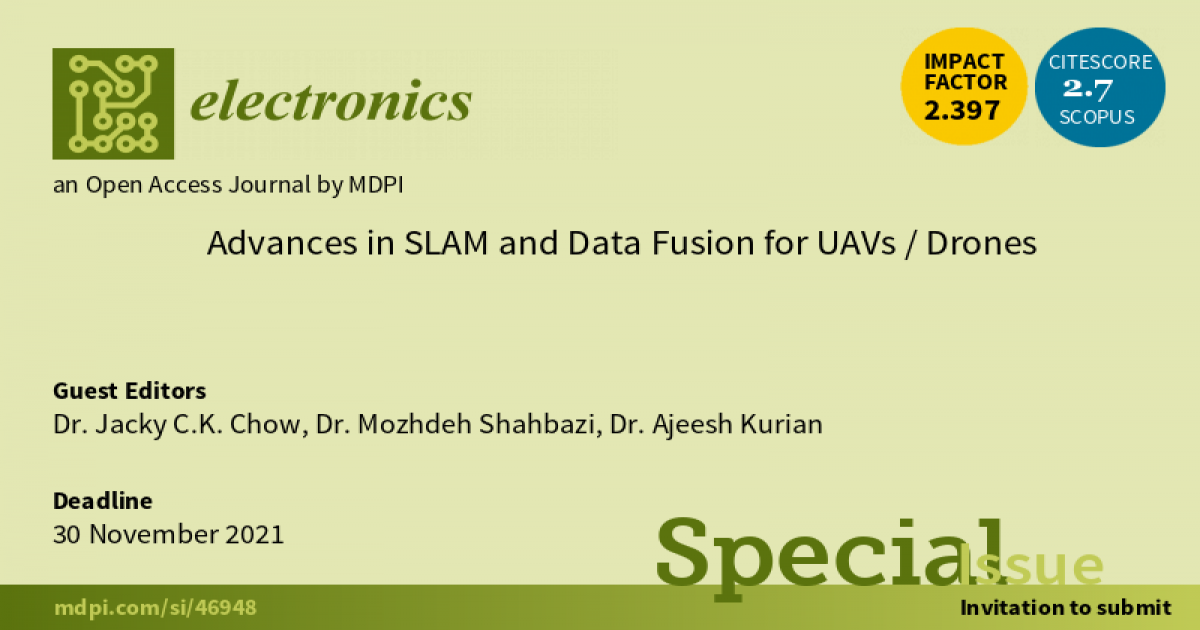Advances in SLAM and Data Fusion for UAVs/Drones
A special issue of Electronics (ISSN 2079-9292). This special issue belongs to the section "Electrical and Autonomous Vehicles".
Deadline for manuscript submissions: closed (30 November 2021) | Viewed by 10617

Special Issue Editors
Interests: photogrammetric computer vision; biomedical imaging; LiDAR; IMU; mobile robotics; simultaneous localization and mapping (SLAM); machine learning; sensor calibration; sensor fusion; numerical optimization
Special Issues, Collections and Topics in MDPI journals
Interests: vision-guided unmanned aerial systems; integration and calibration of ranging and imaging technologies; deep learning
Special Issues, Collections and Topics in MDPI journals
Interests: SLAM; computer vision; inertial navigation systems; signal processing; point cloud processing; LiDAR; calibration
Special Issues, Collections and Topics in MDPI journals
Special Issue Information
Dear Colleagues,
Unmanned aerial vehicles (UAVs) equipped with a variety of sensors can safely acquire real-time, high-resolution sensory data of the environment. This data can be applied in various fields, such as construction, agriculture, entertainment, and transportation. For many of these applications, the autonomy of the drone is of critical importance. UAVs need to be equipped with reliable localization, navigation, and exploration capabilities in order to make sense of complex environments by themselves with little/no interventions from operators. The users of UAV technologies are also inundated with overwhelming amounts of data (e.g., large volumes of imagery). Therefore, intelligent algorithms are needed to control the overflow of data by fusing and transforming disparate data into useful and concise information.
This Special Issue captures the state-of-the-art and emerging solutions for the localization and navigation of UAVs, as well as intelligent processing of data from the miniature sensors onboard.
You may choose our Joint Special Issue in Drones.
Dr. Jacky C.K. Chow
Dr. Mozhdeh Shahbazi
Dr. Ajeesh Kurian
Guest Editors
Manuscript Submission Information
Manuscripts should be submitted online at www.mdpi.com by registering and logging in to this website. Once you are registered, click here to go to the submission form. Manuscripts can be submitted until the deadline. All submissions that pass pre-check are peer-reviewed. Accepted papers will be published continuously in the journal (as soon as accepted) and will be listed together on the special issue website. Research articles, review articles as well as short communications are invited. For planned papers, a title and short abstract (about 100 words) can be sent to the Editorial Office for announcement on this website.
Submitted manuscripts should not have been published previously, nor be under consideration for publication elsewhere (except conference proceedings papers). All manuscripts are thoroughly refereed through a single-blind peer-review process. A guide for authors and other relevant information for submission of manuscripts is available on the Instructions for Authors page. Electronics is an international peer-reviewed open access semimonthly journal published by MDPI.
Please visit the Instructions for Authors page before submitting a manuscript. The Article Processing Charge (APC) for publication in this open access journal is 2400 CHF (Swiss Francs). Submitted papers should be well formatted and use good English. Authors may use MDPI's English editing service prior to publication or during author revisions.
Keywords
- unmanned aerial vehicles
- mapping and navigation
- computer vision, photogrammetry, and remote sensing
- control systems
- signal processing
- GNSS, IMU, UWB, BLE, Sonar, Radar, LiDAR and cameras
- 2D/3D image and point cloud processing
- image orientation
- sensor/data fusion
- machine learning and deep learning.
Benefits of Publishing in a Special Issue
- Ease of navigation: Grouping papers by topic helps scholars navigate broad scope journals more efficiently.
- Greater discoverability: Special Issues support the reach and impact of scientific research. Articles in Special Issues are more discoverable and cited more frequently.
- Expansion of research network: Special Issues facilitate connections among authors, fostering scientific collaborations.
- External promotion: Articles in Special Issues are often promoted through the journal's social media, increasing their visibility.
- Reprint: MDPI Books provides the opportunity to republish successful Special Issues in book format, both online and in print.
Further information on MDPI's Special Issue policies can be found here.
Related Special Issue
- Advances in SLAM and Data Fusion for UAVs/Drones in Drones (7 articles)





